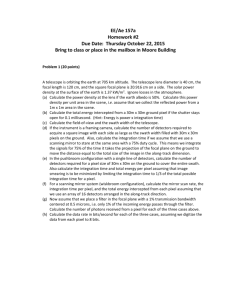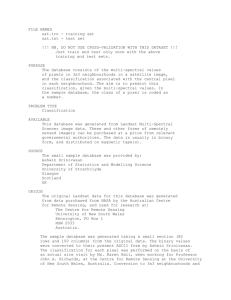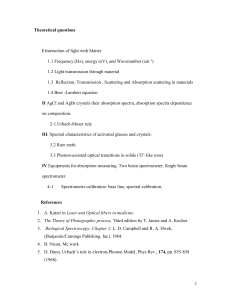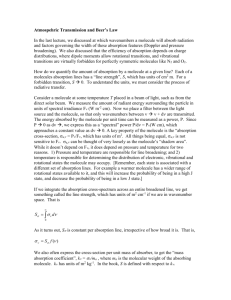Solution
advertisement
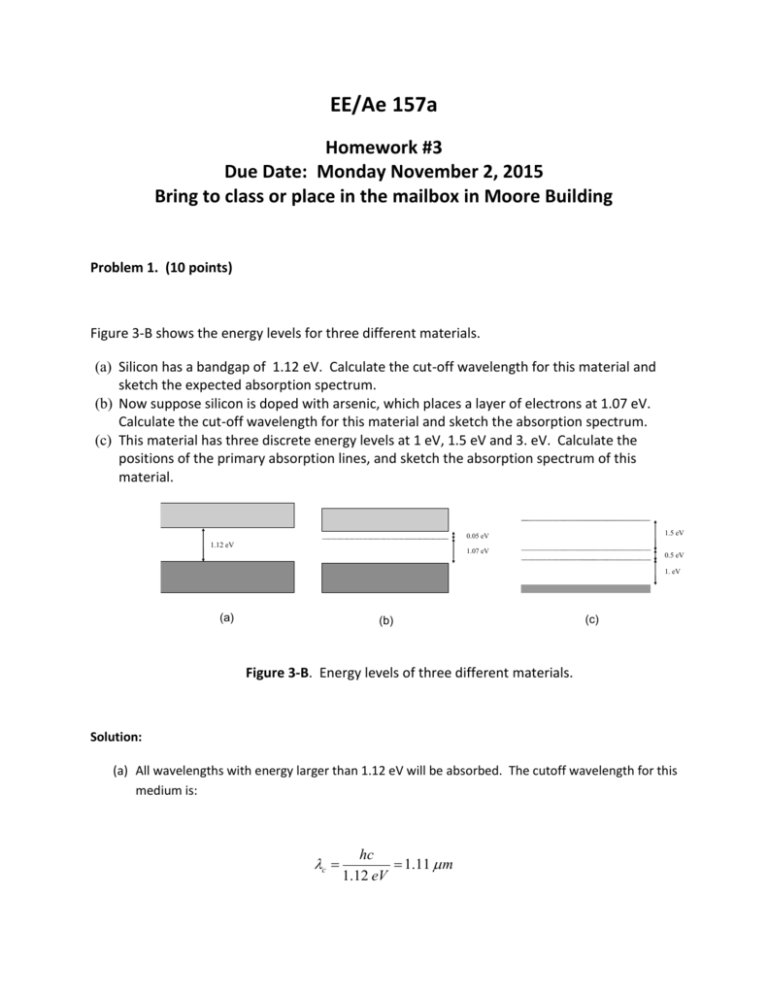
EE/Ae 157a Homework #3 Due Date: Monday November 2, 2015 Bring to class or place in the mailbox in Moore Building Problem 1. (10 points) Figure 3-B shows the energy levels for three different materials. (a) Silicon has a bandgap of 1.12 eV. Calculate the cut-off wavelength for this material and sketch the expected absorption spectrum. (b) Now suppose silicon is doped with arsenic, which places a layer of electrons at 1.07 eV. Calculate the cut-off wavelength for this material and sketch the absorption spectrum. (c) This material has three discrete energy levels at 1 eV, 1.5 eV and 3. eV. Calculate the positions of the primary absorption lines, and sketch the absorption spectrum of this material. 1.5 eV 0.05 eV 1.12 eV 1.07 eV 0.5 eV 1. eV (a) (b) (c) Figure 3-B. Energy levels of three different materials. Solution: (a) All wavelengths with energy larger than 1.12 eV will be absorbed. The cutoff wavelength for this medium is: c hc 1.11 m 1.12 eV Absorption 1 1.12 eV c (b) The addition of the doping layer effectively raises the ground state of the material to 1.07 eV. Therefore, for this material, all wavelengths with energy larger than 1.12 – 1.07 = 0.05 eV will be absorbed. The new cut-off wavelength is c 2 hc 24.9 m 0.05 eV Absorption 1 1.07 eV c 2 (c) In this case we have three primary absorption lines at wavelengths corresponding to the energy levels at 1 eV, 1.5 eV and 3. eV. These lines will be sharp, because the incoming wave has to have exactly these energy levels in order to move an electron from the ground state into each of these levels. The corresponding wavelengths for the primary lines are 1.242 m , 0.828 m , 0.414 m . Absorption 1.5 eV 1 0.5 eV 1.0 eV .414 .828 1.242 Problem 2 (20 points) A telescope is orbiting the earth at 705 km altitude. The telescope lens diameter is 40 cm, the focal length is 120 cm, and the square focal plane is 10 cm on a side. The pixels in the detector are 10 microns on a side. Calculate the swath width, size of the pixels on the ground, and the number of pixels across the swath assuming a pushbroom design. Also, calculate the maximum integration time per pixel, and the resulting data rate. The instrument is now changed into a spectrometer. The incoming light is dispersed using a prism such that the different colors are separated spatially in a direction orthogonal to the pushbroom line array as shown in the figure. To measure the different spectral components, the prism mechanism is scanned so that different colors sweep over the line array. Calculate the scan rate of the dispersion mechanism. If we are to measure 128 spectral channels, what would the integration time per spectral channel? What is the data rate of the spectrometer? Frequency Line Array Space Solution: We find the size of the swath using the imaging geometry: L l H f L Rl f Here H is the orbit altitude, l is the size of the focal plane, and f is the focal length of the camera. In this case, H 705 km, l 10 cm, and f 120 cm, which gives L 58.75 km A 10 micron detector will then project to d 5.875 m on the ground. The number of pixels across the swath is N 10 cm 10, 000 10 m The maximum dwell time per pixel is the time it takes the footprint of the satellite to move the distance equal to the size of a pixel, i.e. 5.875 m. For an orbit altitude of 705 km, the satellite velocity is vs g s Re2 7507.3 m / sec Re R Assuming that the imager points to the surface underneath the spacecraft, the velocity of the footprint is v vs Re 6760.3 m / sec Re R For a pixel of 5.875 m, the integration time is max 0.869 msec To calculate the data rate, we shall assume we use the maximum dwell time per pixel. We then acquire 10,000 data samples every 0.869 msec. Assuming that each sample is coded as 8 bits, we find the data rate to be D 10000 8 87.79 Mbits/sec 0.000869 In the case of the spectrometer, we have to complete all 128 spectral measurements in the time we could make one measurement before. The prism must therefore complete one scan every 0.869 msec. But we can scan the frequencies in increasing order once, followed by decreasing order next. So, we can really use twice this time per scan. The scan rate is then 1 Scan Rate = 2×0.000869 = 575.3 Hz The integration time per spectral channel is 1/128 th of the previous integration time s 6.79 sec The data rate is simply 128 times higher than before, since we are making 128 measurements in the time it took to make one before. Therefore Ds 11.2 Gbits/sec

